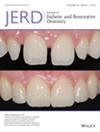Monolithic Hybrid Abutment Crowns (Screw-Retained) Versus Monolithic Hybrid Abutments With Monolithic Crowns (Adhesively Cemented): Three-Year Data of a Prospective Clinical Split-Mouth Study
Abstract
Objectives
This study compares the restoration of single-tooth implants with screw-retained lithium-disilicate hybrid-abutment crowns and single-tooth lithium-disilicate crowns adhesively bonded to hybrid abutments with regard to objective clinical and subjective patient-specific evaluation criteria over a time of observation of 3 years.
Materials and Methods
Two bone-level implants were placed in contralateral sides of the same jaw in 10 patients, each with two single-tooth gaps. After osseointegration, implants were uncovered and an impression was taken. In accordance with the split-mouth design, one implant in each patient was restored with a screw-retained hybrid abutment crown and the other implant with a hybrid abutment and an adhesively bonded single-tooth crown. The restorations were randomly allocated to the implants. Prefabricated titanium bases were used. The ceramic abutments and restorations were fabricated monolithically with pressed lithium-disilicate ceramic. An objective evaluation (survival, technical, or biological complications, FIPS) by the practitioner and a subjective evaluation (satisfaction, OHIP) by the patient were carried out after 3, 6, 12, 24, and 36 months after restoration placement.
Results
Both restoration types showed a survival rate of 100% after 3 years of observation. No technical or biological complications occurred. No significant difference was observed between the two types of restoration neither for objective (survival, technical or biological complications, FIPS) nor subjective (satisfaction, OHIP) evaluation criteria (p > 0.05).
Conclusion
No statistically significant differences were observed between screw-retained and cemented pressed lithium-disilicate restorations on bone-level implants for both objective and subjective evaluation criteria, respectively.
Clinical Significance
Monolithic hybrid-abutment crowns (screw-retained) and monolithic hybrid abutments with single-tooth crowns (cemented) made of pressed lithium disilicate can be used to successfully restore single implants.


 求助内容:
求助内容: 应助结果提醒方式:
应助结果提醒方式:


